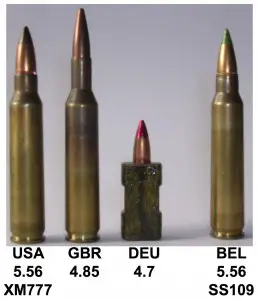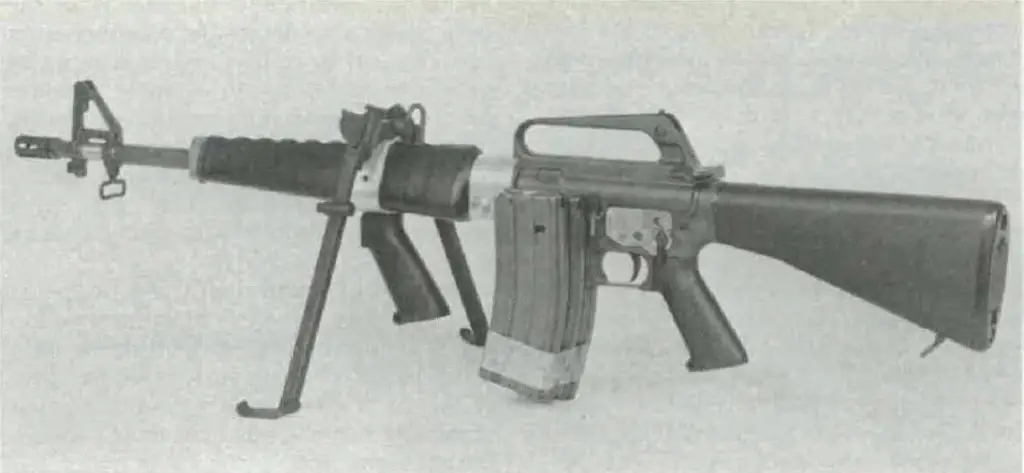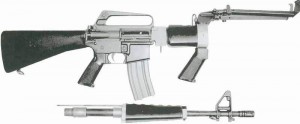The SAWs that never WAS: Intro, and XM106
The M249 Squad Automatic Weapon is widely distributed in the US Army and Marine Corps (even after the Marines replaced many SAWs with M27 Infantry Automatic Rifles). But how did we get to that point, and what other weapons were considered along the way? This series will look at each of the four contenders in turn. The principal objective of this article is to set the stage, and introduce an unfamiliar cousin of a familiar old friend: the XM106 Automatic Rifle, an M16A1 redesigned by Army engineers for the tactical role once filled by the Browning Automatic Rifle in the American rifle squad.
It’s a bit amazing that a SAW program got any traction at all. In 1979, the Army was concerned about the vintage of its small arms and other systems. While we’re most concerned about small arms here, the Army’s RDT&E guys had to develop it all, and they had their hands full trying to field or develop, at that time:
- The XM1 Tank (with 105mm gun; not yet named Abrams).
- The 120mm smoothbore follow-on for the M1. This was principally setting up American manufacture of an already-successful German gun.
- The Infantry Fighting Vehicle and its cav variant (not yet named Bradley).
- The Copperhead laser-guided precision artillery shell.
- The YAH-64 helicopter (“Y” means prototype; the Army was testing 5 prototypes, but they hadn’t selected the night vision and fire control systems yet; everyone remembered the AH-56 Cheyenne, which had gotten to this stage and beyond before its ignominious cancellation).
- The still unnamed MLRS rocket system was in early phases of tests, and precision guided rockets for it were barely on the engineers’ whiteboards.
- Improved missiles: I-HAWK, TOW, and Pershing II.
- New missiles: HELLFIRE and Patriot.
- US production of the superior British 81mm mortar.
- Firefinder radar.
Those are the ones that turned into successful fieldings, but every one was opposed by vocal lobbies, which argued that the weapons cost too much, and would never work. (Some of these opponents were concerned patriots, like John Boyd’s famous reform mafia; others might not have been, like the CDI, a group that toed Ivan’s line so thoroughly that it was rumored to be financed by the USSR, and that did indeed fade from prominence after the USSR went belly up, although no one ever found any proof of anything as far as we know).
To the delight of the opponents, some development projects would turn out to be turkeys, like the DIVAD gun (later named Sergeant York; its fate was sealed when a high-stakes live demo saw it lock on to a latrine fan instead of a hovering, easy-pickin’s drone helicopter). Some would blow their budgets and get put out of their misery by the Carter administration or the Congress. Nobody remembers the US Roland AA missile, or the Stand Off Target Acquisition System, a helicopter with a Rube Goldberg targeting radar that needed a Heath Robinson raising and lowering mechanism.
But all in all, for all that the suits would like to zero out Army R&D, and for all that some projects would be dead ends, the need for these systems was so great, and/or the contractors had promised to manufacture them in so many Congressional districts, that the Army had an RDT&E budget request for $2.927 Billion for FY 80 (which began 1 Oct 79).
The principal small arms program was the SAW (the long-running Air Force/Joint pistol trials, the M231 Firing Port weapon, and a 30mm repeater grenade launcher which never saw type-classification, were some of the others). The Squad Automatic Weapon program was well along; the service needed to complete a developmental and operational test of four prototypes and evaluate the test data. Considering that it would produce a weapon still in the field today, this program’s budget request was almost invisible: $500,000. It was a little less than 2%, not of the RDT&E budget, but of 1% of the RDT&E budget (0.01708% if you do the math; rounds up to 171 10/1000ths of a percent).
The Army had just given up on the idea of a return to a .30 caliber small arm. A study called IRUS-75 evaluated the .30 concept as part of a question of the overall organization and equipment of the future rifle squad; a follow-on study, the Army Small Arms Requirements Study (ASARS), made it clear that the caliber mattered less than having two auto weapons per squad to provide a base of fire, as the BAR had done in days of yore.

The four NATO ammo contenders. Soon after the SAW tests described in this series, NATO chose the SS109.
The Army conduced an extensive computer study that determined the optimum caliber for a SAW was 6mm. This caused the first casualties inflicted by the SAW as logisticians’ heads exploded: they had no desire to stock a third caliber alongside 5.56 and 7.62. Accordingly, the SAW was specified to use 5.56mm ammunition: not the standard M193 ball round, but whatever round came out of new NATO testing, whether it was the FN SS109, the US XM777, or something completely different. The test guns were, as we understand it, set up for XM777. (XM777, like SS109, sought to get more penetration out of the 5.56x45mm cartridge by using a steel penetrator. It was, however, backwards-compatible with the 1:12 rifling of earlier 5.56 rifles. SS109 proved superior in NATO tests to SS109 and experimental British and German small-caliber rounds, and was adopted; the US version is M855).
The Army did not have an entirely free hand in weapons development, since the Joint Services Small Arms Program had been established in December, 1978, as “the senior joint services body for small arms development,” but the Army did retain control of the SAW program. By early 1979, four prototypes were under test by the Material Testing Directorate of the Army’s Aberdeen Proving Ground. One of the four was going to be the SAW and replace two of the rifle squad’s M16A1 rifles. (Doctrine at the time designated one rifleman in each fire time the “automatic rifleman”. He got a bipod and more ammo. The rest of the riflemen were supposed to fire on semi-auto against point targets only).
The four candidates were three belt-fed 5.56mm light machine guns: Ford Aerospace’s XM248; FN’s XM249; H&K’s XM262; and one magazine-fed weapon, the XM106.
The XM106 had the home-field advantage: it was developed by the Army’s own Ballistics Research Laboratory. But it was, by far, the least advanced rifle. It was essentially an M16A1 with a modified fire-control system and a bipod. It fired full-auto only, from an open bolt, and had a heavy buffer system to bring the rate of fire down to 750 RPM. The bipod was an M2 bipod, as used on the M14, but it mounted above the rifle’s barrel. All XM106s appear to have been hand-built, toolroom guns, and there are a few variations among them. The XM106 had a clever, but complex, interchangeable barrel, a desirable feature in a weapon that may be called on to deliver lots of automatic fire. In most XM106s, the front sight base was moved closer to the muzzle end of the barrel (which army records record as 482mm [21.5 in.] including the flash suppressor, the second longest of the contenders), reputedly to extend the gun’s sight radius.
The barrel-changing mechanism removed the front sight and gas tube from the gun, leaving the bipod attached to the receiver. The handguards, as you can see in the picture, split. This system had two drawbacks — one, shared with the M60 and numerous other GPMGs is that rear sight adjustments could only be zeroed for one barrel — when you changed barrels, you changed point of impact, and it might have done something ugly to the accuracy of your weapon. The second drawback is clearly visible in the picture: that gas tube hanging off the spare barrel, just asking some GI to bend, break, or plug it with something.
The XM106 was not only magazine-based, it had its own special magazine — sort of. A spring clip held three 30-round magazines together. When one was exhausted, the auto-rifleman pressed the magazine release and shifted the mag over and reinstalled it. It was another Rube Goldberg / Heath Robinson contrivance, but in the late 1970s there were no reliable high-cap magazines.
We’re not aware of any surviving XM106s. The open-bolt mechanism and the plate renaming the fire selector positions lived on, however, on the M231 Firing Port Weapon. Colt was to reevaluate the M16-based MG and develop a version in conjunction with Diemaco for Canadian Army tests; that would also fire from the open bolt, but it had a superior barrel change system and bipod to those of the XM106.
If the XM106 was the least technically ambitious of the SAW contenders, Ford’s XM248, which instantiated some concepts developed at BRL and elsewhere in the Army ordnance world, was at the opposite end of the spectrum — a technical stretch. But that’s for the next installment.
Other than its influence on Colt’s future private developments, the XM106 was an evolutionary dead end. With four very different guns to choose from, three had to lose, and with its lack of a belt and awkwardness, the XM106 was never really in contention. It’s interesting to compare it to the M27 automatic rifle the Marines ultimately chose to replace most of its SAWs, a weapon that accepted the inconvenience of magazine loading for the benefit of much lighter weight.
That the XM106 was so quickly set aside tells us that “not invented here” wasn’t holding the Army ordnance experts back in the late 70s and early 80s — the gun was designed by their own compadres at the Ballistics Research Laboratory, but it wasn’t the best. Any disappointment that BRL might have had was limited, however. Their firing-port weapon design, a more extensively modified M16A1, was adopted as standard equipment for the new Infantry and Cavalry Fighting Vehicles, and it, too remains in service today — so there’s a little bit of XM106 still out there.
2 thoughts on “The SAWs that never WAS: Intro, and XM106”

Kevin was a former Special Forces weapons man (MOS 18B, before the 18 series, 11B with Skill Qualification Indicator of S). His focus was on weapons: their history, effects and employment. He started WeaponsMan.com in 2011 and operated it until he passed away in 2017. His work is being preserved here at the request of his family.



I seem to recall that examples of the XM106 reside in the Rock Island Arsenal Museum. I keep meaning to go back with a decent camera. Hopefully, the Silent Weapon Alpha prototypes will be back on display next time.
Interesting, because BRL was at Aberdeen, IIRC, and Rodman Labs (which developed the M-235, forerunner of the M-248) was at Rock Island. Rock Island is still working… they built the 5,000-odd M14 EBRs.